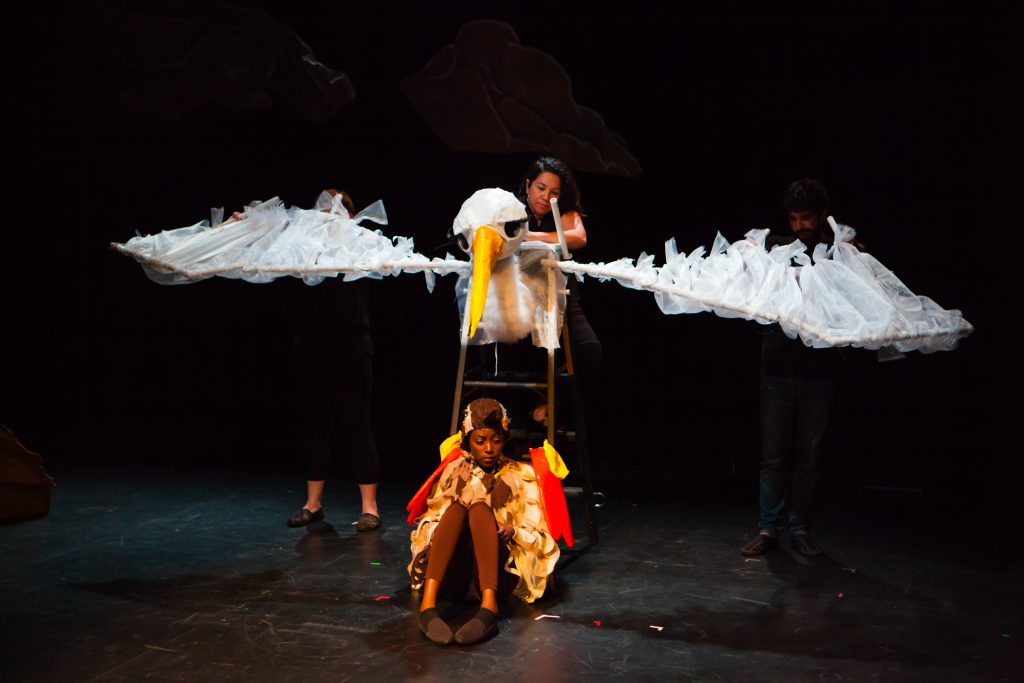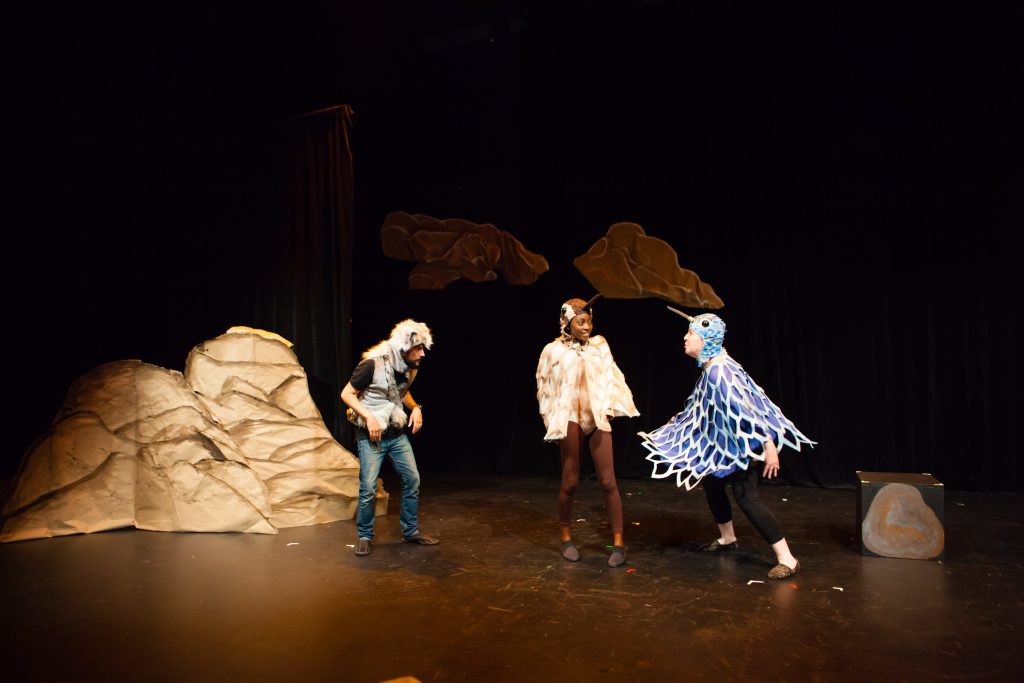Nature Surviving in San Diego

Katherine Harroff, Veronica Burgess, Alexandra Slade, and Justin Tuazon-Martin. (Photo by Rich Soublet II).
The plot starts in the 1990s as doctoral candidate Edward Leopold (Michael Nieto) gives a presentation urging coastal cactus wren’s to be included on the Endangered Species List. His goal is to help the birds survive, but sadly, Edward’s speech turns out to be nothing short of a personal disaster.
Over time, Edward becomes less passionate and more jaded. This is primarily due to his work in property development, which turns him into a resentful human being. Edward’s tale jumps forward to the not too distant future, where he reluctantly decides to aid an organization in building a children’s hospital.
A seemingly separate story follows a timid coastal cactus wren, Wren (Alexandra Slade), whose family seeks a new home after a deadly fire hits San Diego. Persuaded by her mother, Mama Wren (Outreach Coordinator of CCdd, Soroya Rowley), she goes on an epic search for a “mystical” bird known as the Gnatcatcher (Artistic director of CCdd, Katherine Harroff). Along the way, she meets a variety of animals including a self-absorbed Coyote (Justin Tuazon-Martin), an Egret (Veronica Burgess) and a gray whale called Commander Gray (Rowley).
Besides co-starring in the all-ages tale, Harroff and Nieto wrote the piece together. To their credit, they never turn the production into a dull middle school lecture or well-intentioned assembly. They would rather have the audience get emotionally invested in the characters instead of hitting theatregoers over the head with a preachy message about the environment.
The writers incorporate plenty of comic relief with humor that pokes fun at poor television news reporting, unusual traits of non-human organisms and San Diego culture. Almost every scene has at least several jokes, which means there is generally an upbeat tone to the material.
CCdd’s Technical Director, Patrick Kelly, is responsible for making both major plotlines equally engaging. For adult viewers, he has succeeded by putting emphasis on spoken dialogue in Edward’s scenes and focusing on imagery during Wren’s scenes. Wren’s voyage has moments of visual magic courtesy of Kelly’s Julie Taymor-esque puppet design, Kristin McReddie’s vivid costume design and Anthony Januzzi’s occasionally mystical lighting design.
Do not underestimate Andrew Steele and Nieto’s skillful original music or Anne Gehman’s refreshingly unordinary choreography. Some people might take these elements for granted, which is a shame since their contributions heighten the world that has been created at the Theodore and Adele Shank Theatre.Although there is much to recommend, the first half could use fine-tuning, which is to be expected of any world premiere. Soon after Edward’s opening plea, symbolism depicts how his life began to decline with cast members physically bumping or injuring him. This is technically an intelligent concept, yet the abstract episode goes on for a few moments too long.
Nieto, Slade, Harroff and the ensemble (many of them playing multiple roles) generally mix idiosyncratic tendencies with empathetic charisma. If there is a part that could be toned down, that would be Tuazon-Martin’s Coyote. At first, the candid native comes across as an obnoxious egomaniac who does not seem to have much respect for others.
However, Harroff and Nieto give the Coyote a well-developed arc after intermission, which allows Tuazon-Martin to ultimately hold his own with the rest of the players. In fact, Act II runs pretty smoothly by building off the events of Act I at a relatively fast pace.
Parents should also be aware that while kids and adults will probably be enchanted by Wren’s sequences, Edward’s conflicts deal with sophisticated issues that youngsters might not fully grasp. That is not to imply that children will dislike Edward. Older viewers just might have to prepare themselves to discuss the nuances of the humans that inhabit Wrenegades.
There is no word yet on CCdd’s website if they plan on starting season 5 after Wrenegades closes. However, Harroff, Rowley and the rest of the crew have produced so many remarkably ambitious theatrical events, that they deserve a new venue to create original work.
DOWNLOAD CAST AND CREDITS HERE
[box] Show times are Wednesdays at 8:00 p.m, Thursdays at 8:00 p.m, Fridays at 8:00 p.m, Saturdays at 8:00 p.m, Sundays at 4:00 p.m, and Mondays at 7:00 p.m. [/box]

A fan of theatre from a young age, David Dixon began writing reviews while in middle school, for Union Tribune’s Rated G column and sdcnn.com. He was the Entertainment Editor for SDSU’s The Daily Aztec. Currently, he contributes to San Diego Community News Network, a regional reviewer for Talkin’ Broadway, an interviewer for San Diego Theatre Reviews and has won several San Diego Press Club Excellence in Journalism Awards. David is a San Diego Theatre Critics Circle member, an American Theatre Critics Association member & Regional Theatre Tony Award voter.



